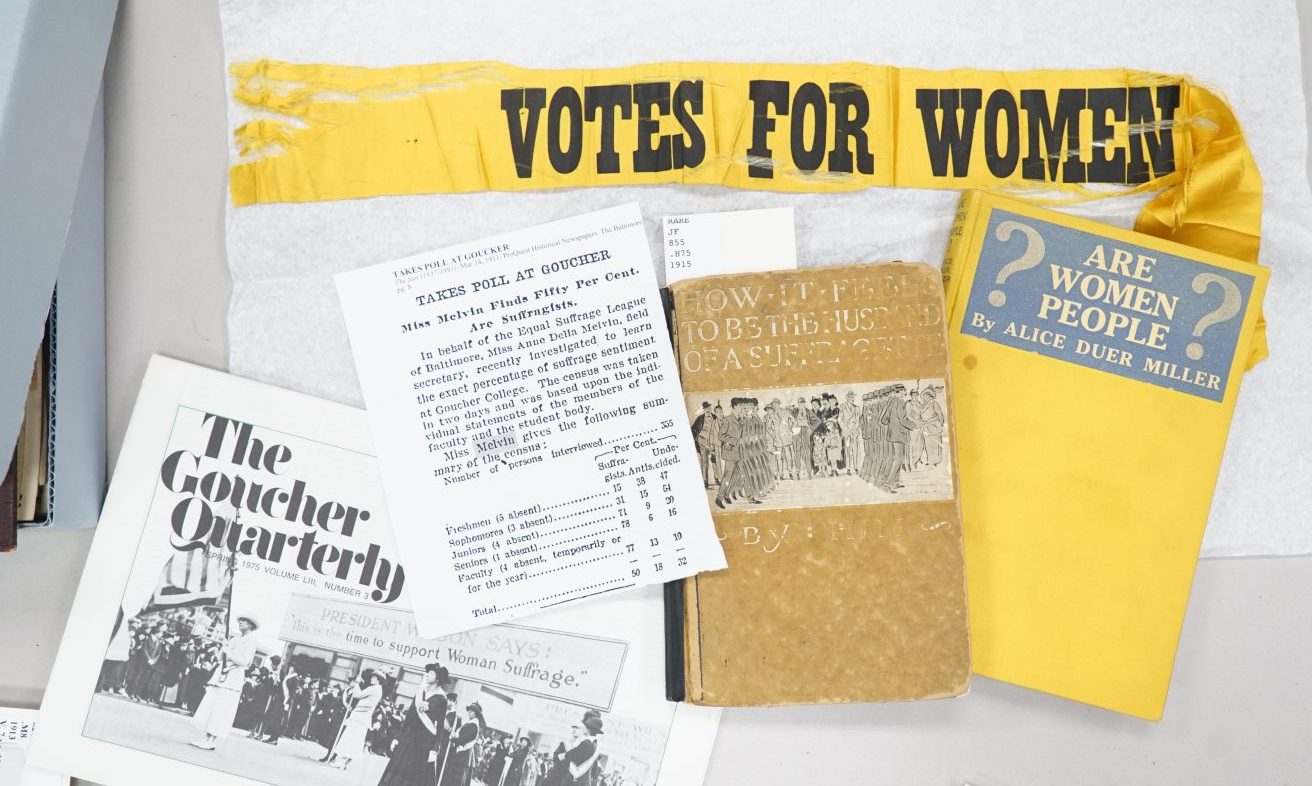Untangling the past of a “Nursery for Militant Suffragists”
Despite spending four years here, Hannah Spiegelman ’15 says her education about the college didn’t start until she graduated.
That’s when the history and art history major was tapped by history professor Tina Sheller ’74, along with fellow history major Clara Hartman ’16, to work in the college’s Special Collections and Archives, researching Goucher’s role in the women’s suffrage movement.
“It’s amazing the amount of history I’ve learned about Goucher that I just didn’t know,” she says. And through the work she’s done, soon others will know it as well. In addition to an exhibit opening this month in the library, the state of Maryland will honor early Goucher professor Lilian Welsh by inducting her into the state’s Women’s Hall of Fame.
“Lilian Welsh seemed to do everything,” Spiegelman explains. “Originally she was hired to do physical examinations, but she became a professor in multiple different areas. She built our physical education department, which was the model for other schools. She was really beloved by everyone here and inspired her students to seek out their dreams and seek out all opportunities, even ones she didn’t have the chance to get herself. And within the Baltimore community she was a real proponent for public health, she worked on a plan to eradicate TB and STDs, just so many things.”
In addition to her health work, Welsh was an ardent suffragist, which is where Spiegelman encountered her in the Goucher library’s archives. Welsh was one of 100 students and faculty members who took part in a Washington, D.C., suffrage parade on March 3, 1913, the day before Woodrow Wilson’s inauguration.
Research into Goucher’s support of suffrage was inspired by a crowdsourcing project run by the journal Women and Social Movements in the United States to create a biographical database of suffrage protestors. One of the SUNY Binghamton professors in charge of the database reached out to Goucher, knowing that a large number of students had taken part.
“This project shines a light on one of Goucher’s jewels that frequently goes unnoticed: Special Collections and Archives in the Goucher library,” says Sheller. “Through the efforts of College Librarian Nancy Magnuson and Special Collections Curator Tara Olivero, Special Collections and Archives has developed an outstanding collection of books, manuscripts, and artifacts. This collection has greatly enriched the educational opportunities of Goucher students, faculty, and alumnae/i.”
Pro-suffrage opinion was strong on campus, but not unanimous, and the college administration went back and forth in its support of the cause. President William M. Guth, while he seemed to support suffrage in the abstract, balked at connecting the college to protests. Spiegelman says this was especially true during the “more militant” phase of suffrage protests, beginning in 1917, when protesting the White House during a time of war was seen as unpatriotic. A Sun editorial cited by Speigelman was sympathetic to the college president: “If Goucher
is to be considered merely a nursery for militant suffragists, it will be apt to suffer and its expanding usefulness will be greatly checked.”
Nonetheless, 30 Goucher women attended a February 1917 march, the largest delegation of any college. They met with a stern rebuke from Guth on their return to Baltimore, but after the war, Speigelman found, he resumed his support for the cause, eventually granting students a day off from classes on November 2, 1920, to exercise their hard- won right to vote.
Sheller hopes this project will lead to more research into Goucher’s history. This sort of research, she says, not only “allows [students] to hone the skills they gained in their undergraduate history courses and to apply them to a meaningful historical project where they can gain experience writing for publication. It also allows them to experience the joy of discovery, and to gain a deeper understanding of Goucher’s past.”
The project, which was supported by the Class of 1960 Rhoda M. Dorsey Archives Endowment and the Brooke and Carol Peirce Center for Undergraduate Research, reclaims what had previously been a lost part of the college’s story. Suffrage protestors’ perceived militancy led in part to their exclusion from the official histories of the college.
“With the current college emphasis on innovation, new technology, and the future,” says Sheller, “it is more important than ever that Goucher students, faculty, and staff have a clear understanding of its past. Ever since the college became coeducational in 1986, it has tended to downplay its single-sex past. It is now time to revisit Goucher’s history as an outstanding women’s college.”
In addition to a paper on her findings, which is in the editing stages, Speigelman and Hartman’s series of biographies of Goucher suffragists are available online at goucherspecialcollections.tumblr. com. They will soon be added to a large database of suffragist biographies at Binghamton University. The library exhibit “A Nursery for Militant Suffragists” will be on display in the library through June 5.

